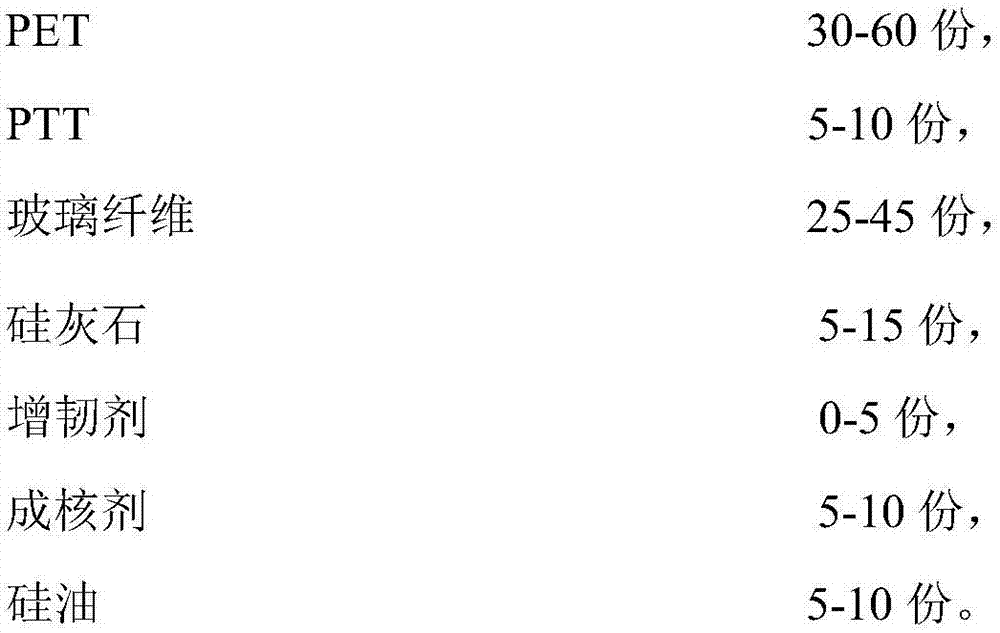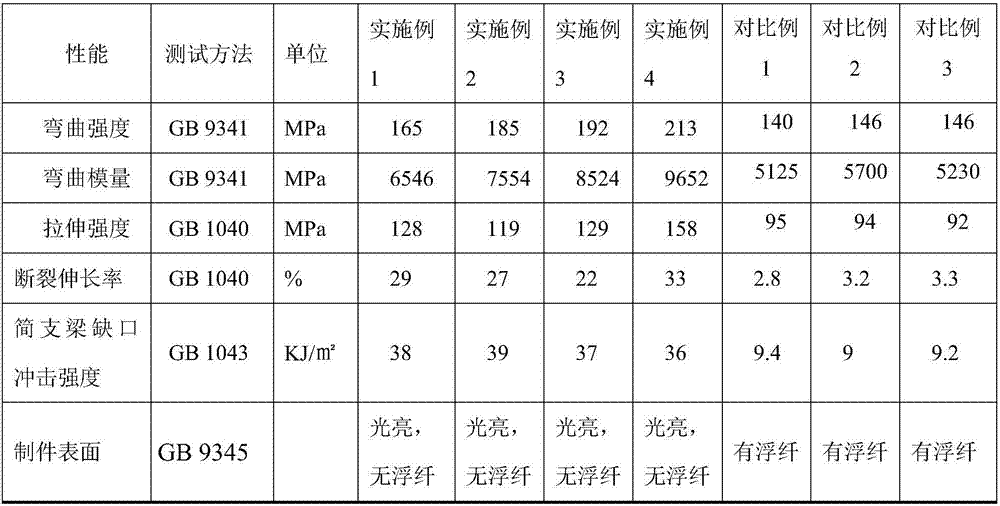Glass fiber-reinforced PET composition without exposed glass fibers and preparation method thereof
A technology without floating fibers and compositions, applied in the field of polymer composite materials, can solve problems such as affecting the appearance and affecting the performance of compression-resistant parts, and achieve the effects of improving flow properties, increasing interface bonding strength, and improving surface floating fibers.
- Summary
- Abstract
- Description
- Claims
- Application Information
AI Technical Summary
Problems solved by technology
Method used
Image
Examples
Embodiment 1
[0030] (1) Dry PET at 110°C for 4 hours; PTT at 110°C for 4 hours;
[0031] (2) Take by weighing 60 parts of dry PET, 5 parts of PTT, 25 parts of glass fiber, 5 parts of wollastonite, 5 parts of sodium benzoate, and 5 parts of silicone oil;
[0032] (3) Stir the material weighed in the above step (2) in a high-speed mixer for 3 minutes;
[0033] (4) Then the above-mentioned uniformly mixed material is added to the feeding port of the twin-screw extruder;
[0034] (5) The material is melted and extruded by a twin-screw extruder, and granulated;
[0035] The processing technology of the twin-screw extruder is as follows: the temperature of the first zone of the twin-screw extruder is 230°C, the temperature of the second zone is 245°C, the temperature of the third zone is 255°C, the temperature of the fourth zone is 265°C, the temperature of the fifth zone is 260°C, and the temperature of the sixth zone The temperature is 265°C, the head temperature is 265°C, and the host speed...
Embodiment 2
[0037] (1) Dry PET at 140°C for 5 hours; PTT at 120°C for 5 hours;
[0038] (2) Weigh dry 40 parts of PET, 10 parts of PTT, 30 parts of glass fiber, 5 parts of wollastonite, 5 parts of toughening agent maleic anhydride grafted ethylene-octene copolymer, 5 parts sodium benzoate, 5 parts of silicone oil;
[0039] (3) Stir the material weighed in the above step (2) in a high-speed mixer for 5 minutes;
[0040] (4) Then the above-mentioned uniformly mixed material is added to the feeding port of the twin-screw extruder;
[0041] (5) The material is melted and extruded by a twin-screw extruder, and granulated;
[0042] The processing technology of the twin-screw extruder is as follows: the temperature of the first zone of the twin-screw extruder is 220°C, the temperature of the second zone is 225°C, the temperature of the third zone is 235°C, the temperature of the fourth zone is 245°C, the temperature of the fifth zone is 240°C, and the temperature of the sixth zone The tempera...
Embodiment 3
[0044] (1) Dry PET at 120°C for 5 hours; PTT at 120°C for 5 hours;
[0045] (2) take by weighing dry 40 parts of PET, 5 parts of PTT, 35 parts of glass fiber, 10 parts of wollastonite, 3 parts of toughening agent ethylene-methyl acrylate copolymer, 5 parts of sodium benzoate, 5 parts of silicone oil;
[0046] (3) Stir the material weighed in the above step (2) in a high-speed mixer for 5 minutes;
[0047] (4) Then the above-mentioned uniformly mixed material is added to the feeding port of the twin-screw extruder;
[0048] (5) The material is melted and extruded by a twin-screw extruder, and granulated;
[0049] The processing technology of the twin-screw extruder is as follows: the temperature of the first zone of the twin-screw extruder is 240°C, the temperature of the second zone is 255°C, the temperature of the third zone is 265°C, the temperature of the fourth zone is 275°C, the temperature of the fifth zone is 270°C, and the temperature of the sixth zone is 270°C. The...
PUM
| Property | Measurement | Unit |
|---|---|---|
| diameter | aaaaa | aaaaa |
| aspect ratio | aaaaa | aaaaa |
| heat deflection temperature | aaaaa | aaaaa |
Abstract
Description
Claims
Application Information
 Login to View More
Login to View More - R&D
- Intellectual Property
- Life Sciences
- Materials
- Tech Scout
- Unparalleled Data Quality
- Higher Quality Content
- 60% Fewer Hallucinations
Browse by: Latest US Patents, China's latest patents, Technical Efficacy Thesaurus, Application Domain, Technology Topic, Popular Technical Reports.
© 2025 PatSnap. All rights reserved.Legal|Privacy policy|Modern Slavery Act Transparency Statement|Sitemap|About US| Contact US: help@patsnap.com


